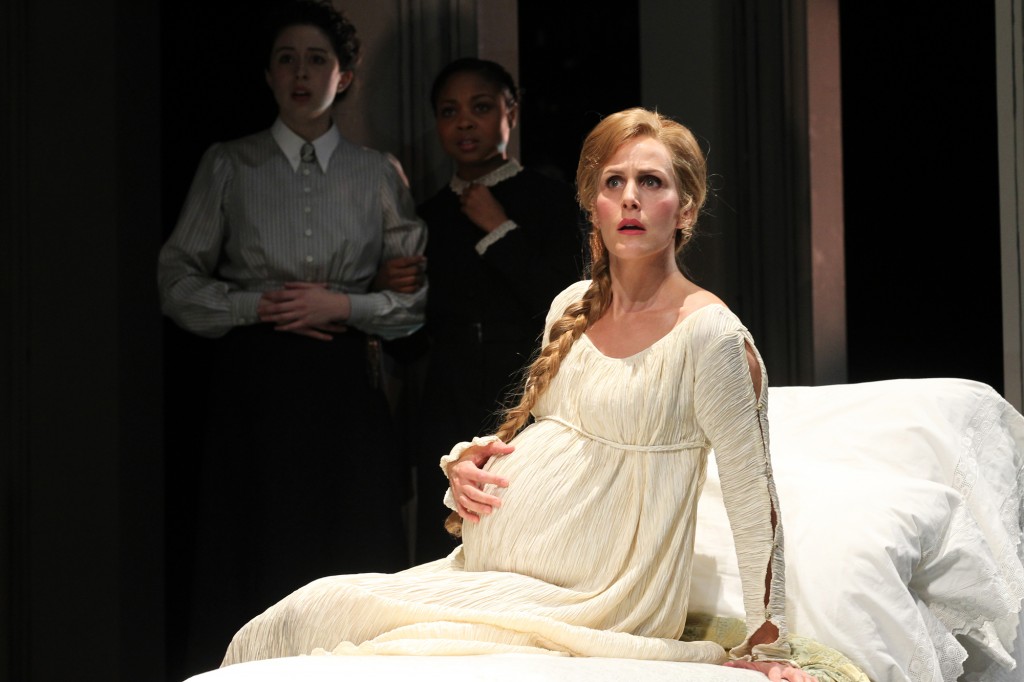
Susannah Schulman as Hermione, Queen of Sicilia (with Adina Verson and Sheria Irving as her attendants), in the Yale Rep production of Shakespeare's The Winter's Tale, directed by Liz Diamond and playing through April 7 at the Yale Repertory Theatre. Photo by Joan Marcus.
The Winter’s Tale
Presented through April 7 by the Yale Repertory Theatre, at the Yale University Theatre, 222 York St., New Haven. (203) 432-1234, www.yalerep.org
By William Shakespeare. Directed by Liz Diamond. Composer: Matthew Suttor. Choreographer: Randy Duncan. Scenic Designer: Michael Yeargan. Costume Designer: Jennifer Moeller. Lighting Designer: Matt Frey. Sound Designer: Elizabeth Atkinson. Production Dramaturgs: Catherine Sheehy, Ilinca Tamara Todorut. Vocal and Text Coach: Grace Zandarski. Stage Manager: Catherine Costanzo. Musicians: Paul Brantley (Cello), Michael Compitello or Adam Rosenblatt (percussion), Jason May (Woodwinds). Performers: Rob Campbell (Leontes), Susannah Schulman (Hermione), Felicity Jones (Paulina, Shepherdess), Hoon Lee (Polixenes), Tyrone Mitchell Henderson (Camillo), Tim Brown (Florizel, Lord 2), Lupita Nyong’o (Perdita), Luke Robertson (Autolycus, Lord 1), Richard Ruiz (Clown, Servant 1), Francis Jue (Gaoler, Dion, Mariner, Shepherd 1), Brian Keane (Antigonus), Thomas Kopache (Old Shepherd, Officer, Time), Adam O’Byrne (Cleomenes, Guard 1, Servant 2, Shepherd 2), Sheria Irving (Dorcas, Lady), Adina Verson (Emilia, Mopsa), Remsen Welsh (Mamillius, Shepherd Boy), Chris Van Zele (Bear).
Don’t ask me why it took so long to post a review of this show. I was there opening night nearly three weeks ago, and now it’s closing Saturday.
You could blame spring fever. The Winter’s Tale is full of it. It’s got a clean, clear vision of what is often perceived as a muddy, misshapen play. In the capable directorial hands of Liz Diamond (who always seems to excel when doing huge-cast shows, whether it’s Brecht’s Saint Joan of the Stockyards, Suzan-Lori Parks’ Death of the Last Black Man in the Whole Entire World, Moliere’s School for Wives, or this), The Winter’s Tale plays like that final scene of Bambi where everyone’s grown up but still frolics in the forest. It’s like Shakespearean climate change.
The last time the Yale Rep traipsed through The Winter’s Tale, back in 1986—with the same set designer, Michael Yeargan!—it was a cold, dark, post-modern affair with metal scaffolding and ironic distancing and sluggish pacing. This time, The Winter’s Tale is a joyous, frolicsome harbinger of a frightfully early Spring.
That’s the wondrous nature of Shakespeare’s so-called “problem” play. Is it tragedy because of the Othello-esque overtures of its opening act, or comedy due to the constant clowning of its middle bit, or romance thanks its moony-eyed ending? Is it wintry like its title, or summery like its Sicilian and Bohemian coastal settings? “Problem plays” don’t seem so problematic anyhow in the age of cable TV series such as Mad Men, Breaking Bad, Weeds or Hung, where laughter turns to despair on a time, comical crimes earn tortuous punishments and all sexual situations are psychologically fraught. Sixteenth century plays which 19th century audiences tagged as inconsistent and superficial seem, in the right director’s hands, a rich lode of gems shining out from a finely tilled surface.
Certainly The Winter’s Tale doesn’t carry the stigma it once did. The Elm Shakespeare Company had no qualms about doing it for several weeks in Edgerton Park two summers ago, and Connecticut Repertory Theatre has a production up now, simultaneous with the Rep’s. Considering the size and intricacy of the play, it’s saying a lot that regional, college and community-based outdoor companies have all embraced it.
The Rep knows how to play it up big. It’s hard to explain what a thrill it is to see 14 people—plus a three-piece live band!—onstage at one time, in this age of economical drama where a cast of three or four can be called an “ensemble.”
It’s party time, from the opening moments, when the cast interacts in an elaborate introductory tableau, right through several scenes of ceremony and pageantry (including a fertility dance) to the finale when longlost family members start piling up in a bleak ballroom where the chandeliers have been shrouded in sorrow.
When the size of the audience is as hale and hearty of that as the cast, the show guarantees—and earns—big laughs, big applause, even the kind of big gasps which you only usually associate with parodies of suspense thrillers, not with actual live theater. The reactions come so strongly because the material is delivered that well. The crowd understands the dangers and delights, and turn into appreciative groundlings.
Shakespeare has a lot to do with this wonderment, of course—even his lesser-known works are intriguing and playable. But it helps when you have a strong staging like Diamond’s. I sense a lot of input from dramaturg (and longtime Yale School of Drama professor) Catherine Sheehy in the sheer good humor and knockabout hilarity on show here; it’s similar in frivolity to the Evan Yionoulis-directed Yale Rep production of King Stag in 2004 which Sheehy had a hand in adapting. Yet where King Stag leapt into the disco stratosphere, The Winter’s Tale keeps its feet on solid ground, illuminating basic human values of honesty, trust, loyalty and generosity and showing why it’s not a good idea to toss your family out of the castle and pick fights with the gods.
As Leontes, the play’s great transgressor and chief plot-motivator, the extraordinary Rob Campbell veers credibly from delusional jealous rage to penance and the mocking of omniscient deities to humble penance and gentle bewilderment. The scenes set in Leontes’ Kingdom of Sicilia carry the bulk of the serious drama and character development. The outdoor episodes in the much looser land of Bohemia bring the mirth and merriment and feisty-farmer jokes.
This production in fact sees these lands as flip sides of each other, down to double-casting the play so that all the actors have a key role in one place and a subordinate one in the other. Yes, I said this was a large ensemble, but we’re faced with around 30 characters here, and a certain economy is still required. Diamond et al. have turned that to their advantage; there are no small parts, only players hanging back as butlers or farmhands until they have their moment in the sun over in the other kingdom.
Some of those performers are exceptional. I’m particularly happy to see Luke Robertson on a Yale stage once again. As a Yale School of Drama student a few years back, he was a valued team player in an an assortment of big ensemble shows, and it’s wonderful to see him older and bulked up a bit, sinking his teeth into the key comic role of Auolycus the thief. Robertson not only brings a new level of shtick to another lively show, he’s a match for the one of the funniest guys I’ve seen on a New Haven stage in many a moon, Richard Ruiz as Autolycus’ patsy Clown. Ruiz, who did a decent Nicely Nicely in the Long Wharf Theater’s downsized 2004 production of Guys and Dolls, at one point gets a huge laugh for, get this, walking across the stage. He has the timing and visual appeal of a silent movie comedian, yet he also handles the Shakespeare dialogue beautifully.
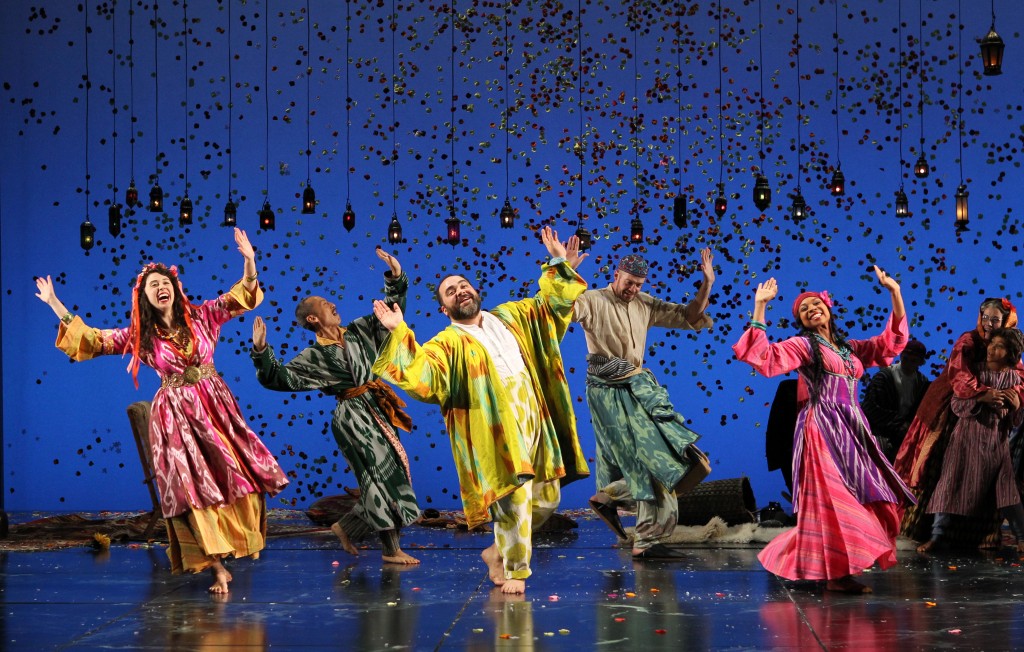
Richard Ruiz, in yellow, leading the dance in The Winter's Tale at Yale Rep through April 7. Photo by Joan Marcus.
Just as classic physical comedy types are used to full advantage (Ruiz is rounded, Robertson more wiry and angular), this production plays up the generational differences among the characters as if they were doing Romeo and Juliet or King Lear instead. Children are believably cast off and belittled by bitter parents. They’re just misunderstood. This really enhances the young romance between the play’s lead lovers, Perdita and Florizel (played by current Yale School of Drama students Lupita Nyong’o and Tim Brown).
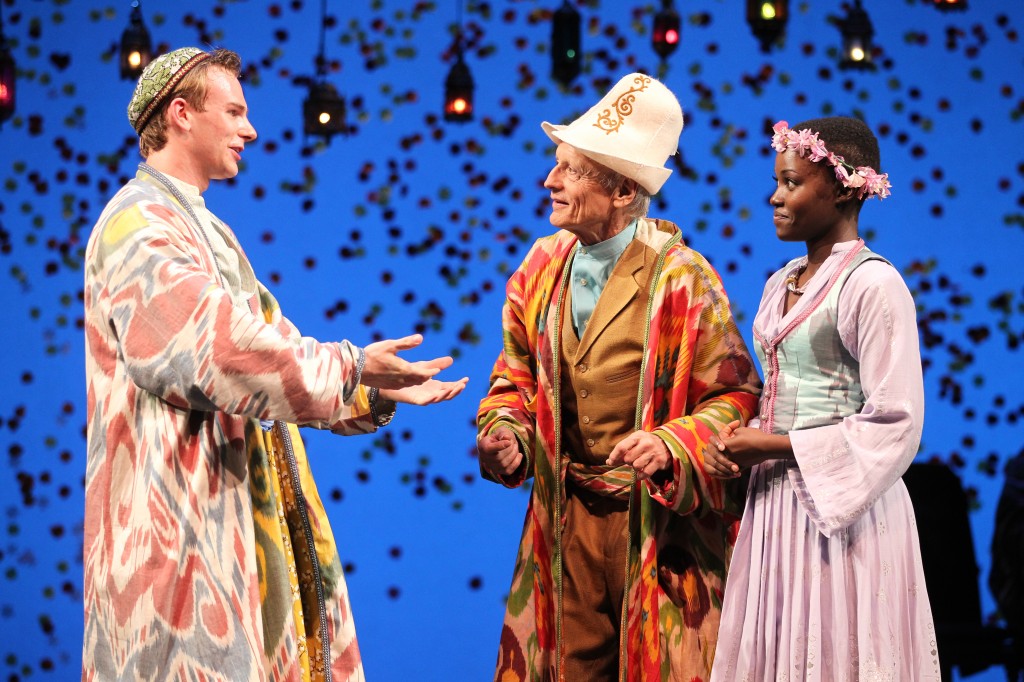
Old Shepherd Thomas Kopache flanked by Tim Brown as Florizel and Lupita Nyong'o as Perdita in The Winter's Tale at Yale Rep. Photo by Joan Marcus.
The older generation lines up as either uncomprehending (the aforementioned Rob Campbell as Leontes, or Thomas Kopache commanding the stage for the comic Old Shepherd monologue which opens the Bohemian half of the play) or empathetic in a doting-older-relative sort of way (the divine Felicity Jones, as no-nonsense as she was last year in The Diary of Anne Frank at Westport Country Playhouse yet as highborn and indignant as she was in Mark Lamos’ production of Lulu at Yale Rep in 2007).
The mannered elders and the impetuous youth march around Michael Yeargan’s massive sets of curtains and stairs and thresholds, soundtracked by that neoclassical trio of musicians, as if they each own the place and don’t quite know what to do with it. The scene is perpetually set for revolution, and it happens.
The whole enterprise is so well thought through and so well cast that it almost has you believing that The Winter’s Tale isn’t one of the vilest bits of sexist, classist, ageist and misogynistic claptrap the bard ever devised. Women and children and trusted servants are treated horribly. Poor farmers are mocked and minimized. Redemptions and revelations, when they come, aren’t really equivalent to depths of the evildoing. The bad guys get off easy in this one, and the impoverished gain respect not by changing the opinions of the wealthy but by becoming wealthy themselves, or through the realization that “the prettiest lowborn lass that ever ran on the green-sward” was in fact an abandoned princess.
Considering the shaky morals at work here, best that the Yale Rep heightens the hilarity and refrains from preaching overmuch. This Winter’s Tale is a statue come to life, a play that reads weird and often acts worse yet now dances and sings with a spring in its step.
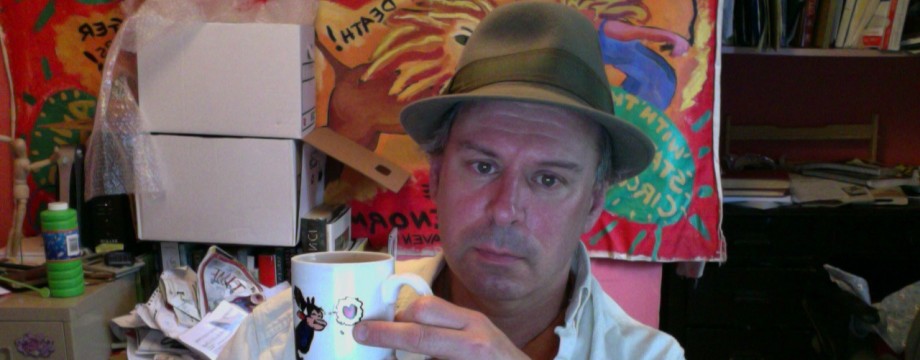
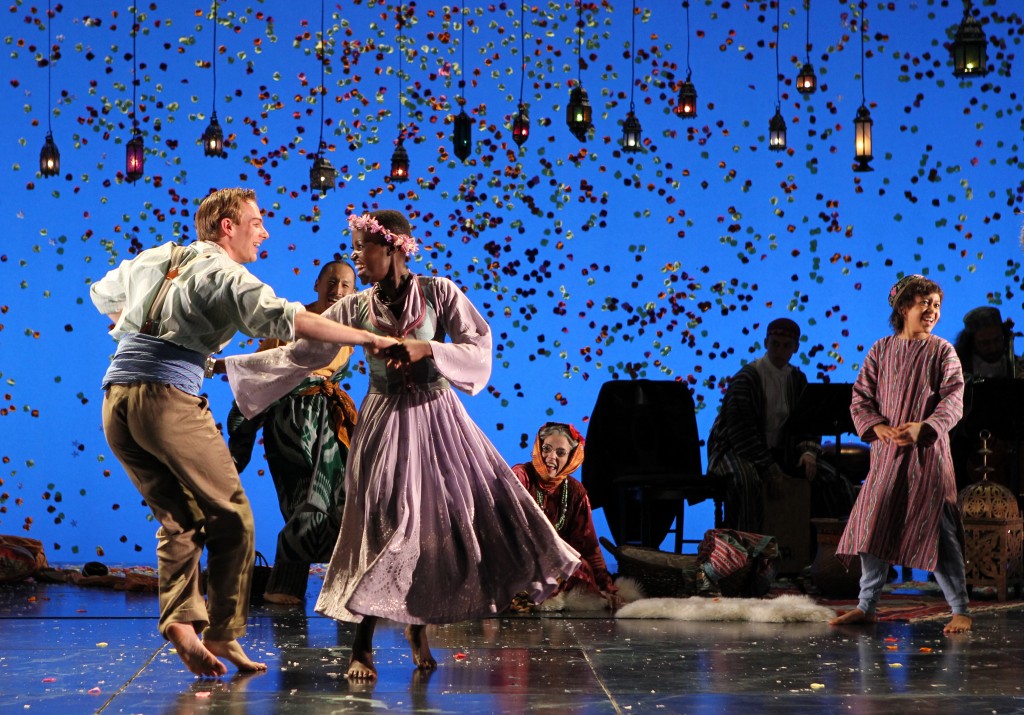
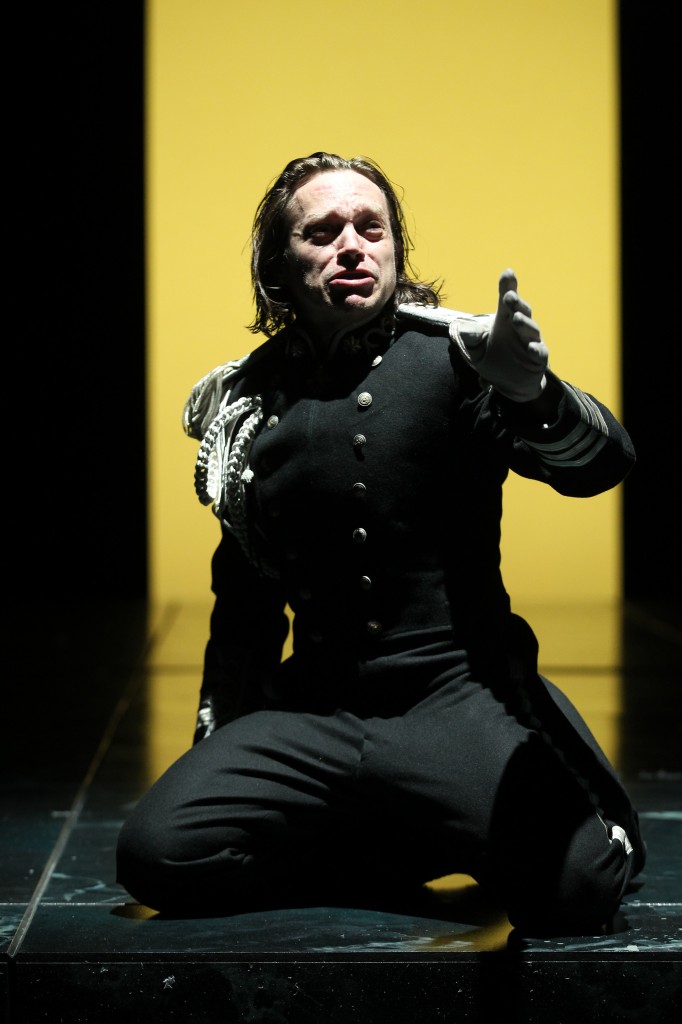
fuck and do sex with teen girl
Sooooo fast. Beautiful